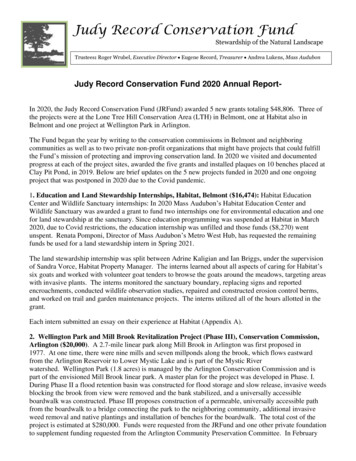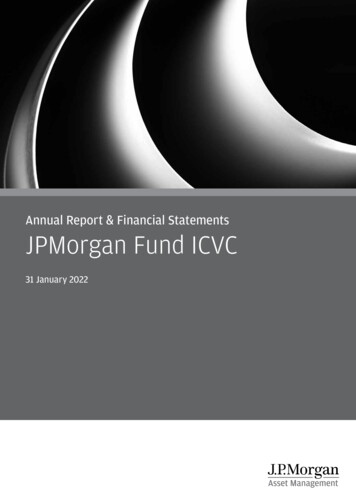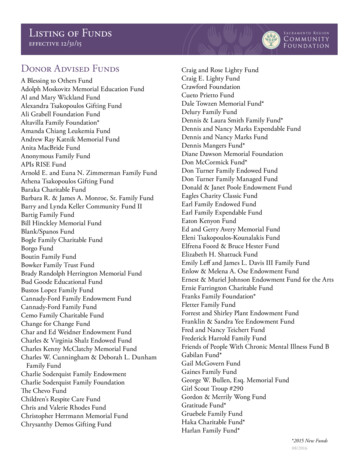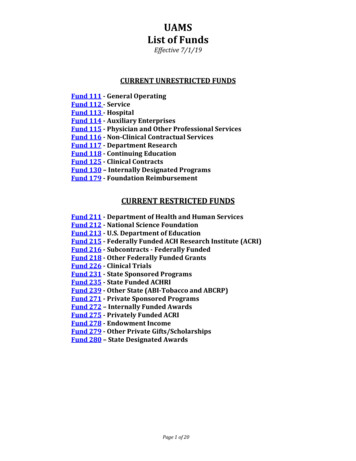
Transcription
Judy Record Conservation FundStewardship of the Natural LandscapeTrustees: Roger Wrubel, Executive Director Eugene Record, Treasurer Andrea Lukens, Mass AudubonJudy Record Conservation Fund 2020 Annual ReportIn 2020, the Judy Record Conservation Fund (JRFund) awarded 5 new grants totaling 48,806. Three ofthe projects were at the Lone Tree Hill Conservation Area (LTH) in Belmont, one at Habitat also inBelmont and one project at Wellington Park in Arlington.The Fund began the year by writing to the conservation commissions in Belmont and neighboringcommunities as well as to two private non-profit organizations that might have projects that could fulfillthe Fund’s mission of protecting and improving conservation land. In 2020 we visited and documentedprogress at each of the project sites, awarded the five grants and installed plaques on 10 benches placed atClay Pit Pond, in 2019. Below are brief updates on the 5 new projects funded in 2020 and one ongoingproject that was postponed in 2020 due to the Covid pandemic.1. Education and Land Stewardship Internships, Habitat, Belmont ( 16,474): Habitat EducationCenter and Wildlife Sanctuary internships: In 2020 Mass Audubon’s Habitat Education Center andWildlife Sanctuary was awarded a grant to fund two internships one for environmental education and onefor land stewardship at the sanctuary. Since education programming was suspended at Habitat in March2020, due to Covid restrictions, the education internship was unfilled and those funds ( 8,270) wentunspent. Renata Pomponi, Director of Mass Audubon’s Metro West Hub, has requested the remainingfunds be used for a land stewardship intern in Spring 2021.The land stewardship internship was split between Adrine Kaligian and Ian Briggs, under the supervisionof Sandra Vorce, Habitat Property Manager. The interns learned about all aspects of caring for Habitat’ssix goats and worked with volunteer goat tenders to browse the goats around the meadows, targeting areaswith invasive plants. The interns monitored the sanctuary boundary, replacing signs and reportedencroachments, conducted wildlife observation studies, repaired and constructed erosion control berms,and worked on trail and garden maintenance projects. The interns utilized all of the hours allotted in thegrant.Each intern submitted an essay on their experience at Habitat (Appendix A).2. Wellington Park and Mill Brook Revitalization Project (Phase III), Conservation Commission,Arlington ( 20,000). A 2.7-mile linear park along Mill Brook in Arlington was first proposed in1977. At one time, there were nine mills and seven millponds along the brook, which flows eastwardfrom the Arlington Reservoir to Lower Mystic Lake and is part of the Mystic Riverwatershed. Wellington Park (1.8 acres) is managed by the Arlington Conservation Commission and ispart of the envisioned Mill Brook linear park. A master plan for the project was developed in Phase. I.During Phase II a flood retention basin was constructed for flood storage and slow release, invasive weedsblocking the brook from view were removed and the bank stabilized, and a universally accessibleboardwalk was constructed. Phase III proposes construction of a permeable, universally accessible pathfrom the boardwalk to a bridge connecting the park to the neighboring community, additional invasiveweed removal and native plantings and installation of benches for the boardwalk. The total cost of theproject is estimated at 280,000. Funds were requested from the JRFund and one other private foundationto supplement funding requested from the Arlington Community Preservation Committee. In February
2020 the JRFund approved a 20,000 request for invasive plant removal, native plantings and benches,with the understanding the money would be released once the CPA funds were approved. The Fund hasbeen notified that the CPA grant was approved for FY2021 and we have now processed the grant check.3. Ecological Management Plan for Lone Tree Hill, Belmont ( 3,750): The Fund provided one-half thecost of an ecological management plan commissioned by the Land Management Committee for Lone TreeHill (LMC). In May 2020 Parterre Ecological Services presented the report, Land Management Plan: ANarrative for Invasive Plant Management and Native Plant Restoration for Lone Tree Hill, to the LMC.(Invasive Plant Management and Native Plant Restoration Plan), The Plan includes guidance formanaging the invasive species at Lone Tree Hill, and it is hoped will ultimately guide the stewards of theconservation area in creating a healthier, more diverse ecosystem for visitors to enjoy.4. Forest & Meadow Restoration at Lone Tree Hill, Belmont ( 4,962.50)In June 2020, the JRFund agreed to pay one-half the cost of an invasive species remediation project to beconducted by Parterre Ecological Services beginning in 2020 and continuing at least through 2021. Thetarget parcel at Lone Tree Hill, designated A1 (inside the red-dotted area on photo, below), is 2.4 acres offorest and shrubland, on the west side of theGreat Meadow extending towards the LTHparking lot on Mill Street. The LMCconsidered clearing and treatment of A1 apriority because it contains the densestpatches of invasive species and because it sitsin the middle of a primary viewshed.In Fall, 2020 the area was mowed andmulched using a forestry mower. Asiaticbittersweet vines crawling up the trunks oftrees were cut by hand. Native trees ― ash,hickory, black cherry, hazelnut, sugar maple,dogwood, bigtooth aspen, sumac and catalpa ― were flagged for preservation and possible seedcollection for a subsequent replanting effort. In December 2020 Parterre invoiced 6,525 of the contractedtotal of 9,925. The rest of the contract will be completed in 2021. (Photo below: Parterre, LMC andJRFund working meeting at LTH, winter 2020 in cleared area A1. Note the stone wall in the background,which was previously hidden by invasive weeds.)
5. Great Meadow Management, Lone Tree Hill, Belmont ( 3,619.50)The JRFund agreed to share half the 7,239 cost of remove of woody invasive low value volunteer treesfrom the Great Meadow. The contractor is Tree Specialist who will also prune, and cable stabilize the“lone” hickory in the center of the meadow and large aged maple to the west. Tree Specialists hasinvoiced and received payment of 3,481 (JRFund share 1,740.50) with the remaining 3,758 to becompleted in 2021.Ongoing Projects: Lone Tree Hill (LTH), Belmont Tree Planting: The JRFund was prepared to fundthe fourth year of planting white pine trees in the Pine Allee at Lone Tree Hill. However, the project wassuspended in 2020 because of the Covid pandemic. On positive note, the trees planted between 20162019 are generally doing well, with the exception of some deer browsing on the growing tips of somesaplings.Financial Report January-December 2020The Judy Record Conservation Fund began 2020 with a balance of 1,012,573, on January1. The Fund had expenses of 26,024 as follows: The Fund transferred 16,474 to Habitatfor internships; paid the Town of Belmont 3,750 for the Ecological Management Plancompleted by Parterre Ecological and 3,300 for work ecological management workcompleted at Lone Tree Hill in 2020. Roger Wrubel received a stipend of 2,500 foradministration of the Fund June-December 2020. The Fund received gifts of 875 during2020. With dividends, interest and market gains from investments the Fund ended the yearwith a balance of 1,115,908, on December 31. The Fund has outstanding payments of 20,000 due to the Arlington Conservation Commission for the Wellington Park and MillBrook Revitalization Project (Phase III) and a 3,313 payment to the Town of Belmont,
for work completed but not invoiced by Parterre Ecological on the Forest & MeadowRestoration Project at Lone Tree Hill.The Judy Record Conservation Fund (JRFund) was established in 2001 by family, friends,and members of the McLean Open Space Alliance and the Belmont Land Trust, whowished to honor Judy’s contributions to land conservation. The JRFund provides grants tosupport protecting, maintaining, restoring, and acquiring conservation lands in the Town ofBelmont and the neighboring communities of Lexington, Cambridge, Waltham,Watertown and Arlington. In addition, the Fund considers projects, within conservationlands, that further the development of multi-use paths, off road hiking and biking trails anduniversally-accessible trails. The JRFund will also provide support for internships andfellowships, with recognized conservation organizations, fostering the next generation ofland conservation leaders.This Annual Report was prepared by Roger Wrubel, Executive Director and reviewed andapproved by fellow trustees of the JRFund, Eugene Record and Andrea Lukens.
Appendix A: Habitat Internship Reflections, Summer 2020Internship Reflection - Ian BriggsIt has been an enriching experience to spend the past three months at Habitat Education Center andWildlife Sanctuary in the role of Land Steward Intern. After just several hiking visits in the fall of 2019, Ifelt a connection that inspired me to want to get involved as a volunteer. Volunteering acquainted me withstaff and encouraged me to want to learn more about Habitat’s objectives, and that eventually led toapplying for this role.As Sandy told me when I first started, baseline priorities would be to make sure that goats, guests, andtrails are cared for. On the surface, this seemed straightforward, but what I learned over time is thatthese three categories are all intricately connected. Goat care included leading volunteers to cull andwork alongside our companions in the meadows. Habitat’s most renowned team members also served asa good segue into educating the public about our meadow restoration efforts, which included, but are notlimited to, controlling invasive plants, protecting desirable shrubs and trees, maintaining a diverse andgraded vegetation height to erase a hard line between the meadow and surrounding woodland, sowingnew, native grass and flower seed into soil cavities, and making observations about areas “mowed” bygoats versus those that were not. And then the trails, which serve as the vessels through Habitat for bothanimal and human movement, required attention in the form of signage and fencing, managingovergrowth, identifying and controlling erosion, compaction, and root surfacing, and preserving trailside(or sometimes on-trail) wildlife habitat. This work had the ultimate goal of creating trail accessibility andsafety for all.I was lucky to work with and learn from four outstanding team members: Sandy Vorce, Erika Harimoto,Becky Nesnevich, and Adrine Kaligian with Sandy educating us on the best ecological managementpractices and the reasons for those practices. I was humbled at being selected and trusted to fulfill theexpectations of this grant-funded position, and I am grateful to the Judy Record Conservation Fund forsponsoring this opportunity.
Internship Reflection - Adrine KaligianI have been incredibly fortunate to return to Habitat as a Land Steward Intern for a second summer,especially considering the events of the past six months.Beginning work in late June, it was clear that things were going to be extremely different compared tolast summer, but I was looking forward to seeing the changes. Without summer camp taking place, ausual day on property staff looked vastly different - no preparing the building and stocking thebathrooms, no educational activities with the goats in their playpen, and no fluorescent parking vests inthe afternoon. While the change in the status quo was strange at first, time was quickly filled due to thelack of volunteers and reduced staff. Every morning, the goat herd went to the meadow and ate freshvegetation for at least an hour or two – sometimes more -- which improved their diets and overall health.To cope with fewer volunteers and social distancing guidelines, goat “pods” were formed to work withstaff in keeping the goats healthy and safe in themornings. Leading pods most mornings meantdelegating tasks and deciding what jobs could be donebased on the number of volunteers and their skill levels,which made every day a little different.Despite the incredibly strange circumstances of thesummer, my time at Habitat has been wonderful. Ienjoyed leading new projects, working with andteaching new volunteers, and solving problems whenthey arose. Most of all, I loved spending my summeroutside, with a community of people who love Habitatas much as I do.
Center and Wildlife Sanctuary internships: In 2020 Mass Audubon's Habitat Education Center and . unspent. Renata Pomponi, Director of Mass Audubon's Metro West Hub, has requested the remaining funds be used for a land stewardship intern in Spring 2021. . considered clearing and treatment of A1 a priority because it contains the densest











